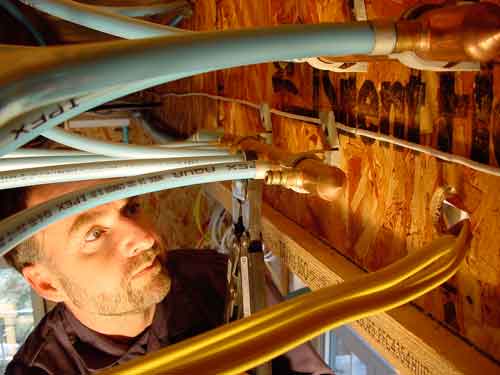How should I rout flexible synthetic water supply pipes underneath our cottage? I’m especially unclear about whether or not we need to use a manifold and where it should be located.

Flexible plastic water pipes are becoming more popular because they’re so much quicker and easier to install than rigid copper. One reason is that you need fewer fittings. Simply bend the pipes where they need to go. A manifold is a piece of plumbing hardware that acts as a central distribution point for smaller pipes spidering off to serve plumbing fixtures in the area. Manifolds are fed by one main pipe, and there are two advantages to using them:
- They can reduce the amount of pipe you need for your installation
- They help deliver better water pressure
The pipes you’d use to feed individual fixtures will be 1/2-inch in diameter, since that’s what most fixtures are made to take. If you fed several fixtures in series off of one 1/2-inch line, you’d get very low water pressure when two or more fixtures are flowing at once. Since a manifold is fed by a larger 3/4-inch line, it’ll deliver enough water to keep several fixtures flowing properly when they’re fed from the manifold.
A manifold saves pipe by letting you deliver water to one central location with just one line then sprout off from there with pipes leading to various fixtures. That said, this approach only makes sense if you have several closely spaced fixtures to feed. If faucets are spread out at your cottage, consider something else. Running a 3/4-inch main line along a rout place that comes closest to most fixtures, then tap off from that 3/4-inch line with 1/2-inch feeder lines to the various fixtures works, too. This is the way copper pipe is usually installed, and it works well in cases where you don’t have a cluster of fixtures. You’ll get full water pressure, even when several plumbing fixtures are flowing at the same time.



